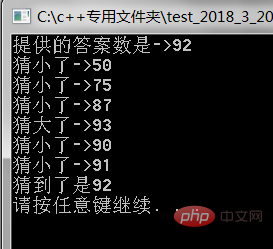 Backend Development
Backend Development
 C#.Net Tutorial
C#.Net Tutorial
 How to generate random numbers from 1 to 100 in C language (with code)
How to generate random numbers from 1 to 100 in C language (with code)
How to generate random numbers from 1 to 100 in C language (with code)

How to generate random numbers from 1 to 100 in C language? I think everyone wants to know about it, so without further ado, let’s learn about it with the editor.
How to generate random numbers in C language
Generate 10 random numbers from 1 to 100
Without further ado, let’s get straight to the program.
#include<stdio.h>#include<stdlib.h>#include<time.h> int main()
{int ret = 0;
srand((unsigned int)time(NULL));for(int i=0; i<p><img src="/static/imghw/default1.png" data-src="https://img.php.cn/upload/image/171/688/281/1593401322583907.png" class="lazy" title="1593401322583907.png" alt="How to generate random numbers from 1 to 100 in C language (with code)"></p>
<p>This program is used to generate 10 random numbers. Next, we will talk about the structure of this program in detail. </p>
<p><strong>Analysis of random number generation code</strong></p>
<p><strong>The key code of the above program is: </strong></p>
<pre class="brush:php;toolbar:false"> srand = ((unsigned)time(NULL));
ret = rand()%100;rand() The header file required for the function is
#include<stdlib.h></stdlib.h>
rand() is a function that generates pseudo-random numbers. It generates random numbers according to a certain sequence, but its sequence is fixed. :

Every time the program is executed, it will give random numbers according to this sequence, so if there are no restrictions on rand(), the random numbers generated will not be random enough. .
The header file required by the time() function is:
#include<time.h></time.h>
time() function. It is worth noting that the formal parameter of the time function is a Pointer variables are usually written as time(NULL).
The function of this function is to return the time from 00:00:00 on January 1, 1970 to the time you first ran it on the computer (for example: 14:14:00 on March 24, 2018). This number is random and changes as your computer runs.
The header file required by the srand() function is:
#include<stdlib.h></stdlib.h>
The srand() function is a pseudo-random number generator seed, which gives the rand() function a generated A starting point. When using the rand() function alone, it takes 1 as the default parameter. The formal parameter of srand() is an unsigned type, that is, unsigned type, which can be int, float, char, etc.
But in order to achieve the random number effect here, the time() function will be used to generate a starting point, which directly acts on the rand() function.
Note:
ret = rand()%100;
rand() 0 is to generate a random number within 100.
Interesting little program
This is a small program for the computer to guess numbers by itself.
#include<stdio.h>#include<time.h>#include<process.h>#include<stdlib.h>#include<windows.h>int main()
{ int ret = 0; int guess = 0; int left = 0; int right = 100;
srand((unsigned int)time(NULL));
ret = rand() % 100; printf("提供的答案数是->%d\n",ret);
guess = 50; while (1)
{ if (guess > ret)
{ printf("猜大了->%d\n", guess);
right = guess;
guess = (right + left) / 2;
Sleep(1000);
} else if (guess %d\n", guess);
left = guess;
guess = (right + left) / 2;
Sleep(1000);
} if (guess == ret)
{ printf("猜到了是%d", guess); break;
}
}
system("pause "); return 0;
}</windows.h></stdlib.h></process.h></time.h></stdio.h>
The idea of dichotomy is used here, allowing the computer to guess a number within 100.
The Sleep() function is used to delay the printing time. The parameter unit of the Sleep() function is ms, so 1000ms=1s.
Thank you for reading
This article is reproduced from: https://blog.csdn.net/H_Strong/article/details/79678269
Recommended tutorial: "C language"
The above is the detailed content of How to generate random numbers from 1 to 100 in C language (with code). For more information, please follow other related articles on the PHP Chinese website!

Hot AI Tools

Undresser.AI Undress
AI-powered app for creating realistic nude photos

AI Clothes Remover
Online AI tool for removing clothes from photos.

Undress AI Tool
Undress images for free

Clothoff.io
AI clothes remover

Video Face Swap
Swap faces in any video effortlessly with our completely free AI face swap tool!

Hot Article

Hot Tools

Notepad++7.3.1
Easy-to-use and free code editor

SublimeText3 Chinese version
Chinese version, very easy to use

Zend Studio 13.0.1
Powerful PHP integrated development environment

Dreamweaver CS6
Visual web development tools

SublimeText3 Mac version
God-level code editing software (SublimeText3)

Hot Topics
 1655
1655
 14
14
 1414
1414
 52
52
 1307
1307
 25
25
 1253
1253
 29
29
 1227
1227
 24
24
 C language data structure: data representation and operation of trees and graphs
Apr 04, 2025 am 11:18 AM
C language data structure: data representation and operation of trees and graphs
Apr 04, 2025 am 11:18 AM
C language data structure: The data representation of the tree and graph is a hierarchical data structure consisting of nodes. Each node contains a data element and a pointer to its child nodes. The binary tree is a special type of tree. Each node has at most two child nodes. The data represents structTreeNode{intdata;structTreeNode*left;structTreeNode*right;}; Operation creates a tree traversal tree (predecision, in-order, and later order) search tree insertion node deletes node graph is a collection of data structures, where elements are vertices, and they can be connected together through edges with right or unrighted data representing neighbors.
 The truth behind the C language file operation problem
Apr 04, 2025 am 11:24 AM
The truth behind the C language file operation problem
Apr 04, 2025 am 11:24 AM
The truth about file operation problems: file opening failed: insufficient permissions, wrong paths, and file occupied. Data writing failed: the buffer is full, the file is not writable, and the disk space is insufficient. Other FAQs: slow file traversal, incorrect text file encoding, and binary file reading errors.
 CS-Week 3
Apr 04, 2025 am 06:06 AM
CS-Week 3
Apr 04, 2025 am 06:06 AM
Algorithms are the set of instructions to solve problems, and their execution speed and memory usage vary. In programming, many algorithms are based on data search and sorting. This article will introduce several data retrieval and sorting algorithms. Linear search assumes that there is an array [20,500,10,5,100,1,50] and needs to find the number 50. The linear search algorithm checks each element in the array one by one until the target value is found or the complete array is traversed. The algorithm flowchart is as follows: The pseudo-code for linear search is as follows: Check each element: If the target value is found: Return true Return false C language implementation: #include#includeintmain(void){i
 How debian readdir integrates with other tools
Apr 13, 2025 am 09:42 AM
How debian readdir integrates with other tools
Apr 13, 2025 am 09:42 AM
The readdir function in the Debian system is a system call used to read directory contents and is often used in C programming. This article will explain how to integrate readdir with other tools to enhance its functionality. Method 1: Combining C language program and pipeline First, write a C program to call the readdir function and output the result: #include#include#include#includeintmain(intargc,char*argv[]){DIR*dir;structdirent*entry;if(argc!=2){
 C language multithreaded programming: a beginner's guide and troubleshooting
Apr 04, 2025 am 10:15 AM
C language multithreaded programming: a beginner's guide and troubleshooting
Apr 04, 2025 am 10:15 AM
C language multithreading programming guide: Creating threads: Use the pthread_create() function to specify thread ID, properties, and thread functions. Thread synchronization: Prevent data competition through mutexes, semaphores, and conditional variables. Practical case: Use multi-threading to calculate the Fibonacci number, assign tasks to multiple threads and synchronize the results. Troubleshooting: Solve problems such as program crashes, thread stop responses, and performance bottlenecks.
 How to output a countdown in C language
Apr 04, 2025 am 08:54 AM
How to output a countdown in C language
Apr 04, 2025 am 08:54 AM
How to output a countdown in C? Answer: Use loop statements. Steps: 1. Define the variable n and store the countdown number to output; 2. Use the while loop to continuously print n until n is less than 1; 3. In the loop body, print out the value of n; 4. At the end of the loop, subtract n by 1 to output the next smaller reciprocal.
 How to define the call declaration format of c language function
Apr 04, 2025 am 06:03 AM
How to define the call declaration format of c language function
Apr 04, 2025 am 06:03 AM
C language functions include definitions, calls and declarations. Function definition specifies function name, parameters and return type, function body implements functions; function calls execute functions and provide parameters; function declarations inform the compiler of function type. Value pass is used for parameter pass, pay attention to the return type, maintain a consistent code style, and handle errors in functions. Mastering this knowledge can help write elegant, robust C code.
 Integers in C: a little history
Apr 04, 2025 am 06:09 AM
Integers in C: a little history
Apr 04, 2025 am 06:09 AM
Integers are the most basic data type in programming and can be regarded as the cornerstone of programming. The job of a programmer is to give these numbers meanings. No matter how complex the software is, it ultimately comes down to integer operations, because the processor only understands integers. To represent negative numbers, we introduced two's complement; to represent decimal numbers, we created scientific notation, so there are floating-point numbers. But in the final analysis, everything is still inseparable from 0 and 1. A brief history of integers In C, int is almost the default type. Although the compiler may issue a warning, in many cases you can still write code like this: main(void){return0;} From a technical point of view, this is equivalent to the following code: intmain(void){return0;}



